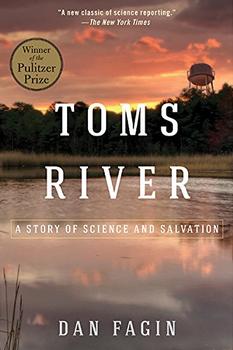Summary | Excerpt | Reviews | Beyond the Book | Readalikes | Genres & Themes | Author Bio

A Story of Science and Salvation
by Dan FaginExcerpt
Toms River
It is no small challenge to spend long days and longer nights in a place where children die, but Lisa Boornazian had the knack. She began working at The Children's Hospital of Philadelphia in 1991, during the summer of her senior year of nursing school at Villanova University. The following year she found a home in the cancer ward at CHOP. Back then she was Lisa Davenport, and not much older than some of her patients. "I loved working in oncology. I saw plenty of nurses who came to work at the unit and it wasn't what they expected. They just couldn't stay. But I loved it," she remembered. The ward was a surprisingly lively place, where little kids dashed down the wide hallways with their wheeled intravenous stands clattering beside them. The older children, though, were much more difficult to deal with. "The teenagers had a grasp of death, and what the diagnosis meant," Boornazian said. "The younger kids mostly had no idea." Those with brain or bone cancers faced long odds. Survival rates were better for children with blood cancers, principally leukemia and lymphoma, but their treatments took many months and were brutal: chemotherapy, often followed by radiation and bone marrow transplants.
The work shifts on the oncology ward were organized in a way that made it impossible for the nurses to keep an emotional distance from their assigned patients, since the same three or four nurses would take care of a child for months on end. Their relationships with parents were equally intense. Many parents practically lived in the ward and went home only to shower and change clothes before rushing back. The nurses worked under the unforgiving gaze of mothers and fathers driven half-mad by lack of sleep and the sight of their children enduring a pitiless cycle of excruciating needle sticks, nausea attacks, and dressing changes. Parents would frequently take out their anger on the nurses, and the nurses who lasted on the ward learned to respond without rancor or condescension. The long shifts, especially the sleepless overnights, created an intimacy among nurse, parent, and child that no one else could share—certainly not the doctors and social workers, who were mere transients by comparison. The nurses were family. And when it was time for a funeral, the nurses did what family members do: They showed up, and they mourned.
Funerals were part of the ritual of life on the oncology ward, and Lisa Boornazian (she married in 1993) attended her share, in towns all over New Jersey, Pennsylvania, and Delaware. One in particular stuck in her mind. It was for a vivacious young woman named Carrie-Anne Carter who was diagnosed with Ewing's sarcoma, a rare bone cancer, during her senior year of high school. She was in treatment for more than a year, and Boornazian grew very close to her family. When the teenager died on February 6, 1995, Boornazian decided to make the two-hour drive from Philadelphia to attend the funeral in a town she had never visited before: Toms River, New Jersey.
Although Boornazian had never been to Toms River, she knew the name well. By 1995, everyone who worked on the oncology ward at Children's Hospital knew about Toms River. Many years later, she explained why. "We began to notice that we were getting a lot of kids from the Toms River area" in 1993 and 1994, Boornazian recalled. "It wasn't just me. All of the nurses noticed it." CHOP drew its young cancer patients from a vast geographic area of more than ten million people, and some families would travel even farther—from as far away as South America and the Middle East, if they could afford it.
Yet when Boornazian and the other nurses would look at the charts of the two-dozen or so patients admitted to the oncology ward in a typical month, there always seemed to be at least one or two from a town with a year-round population of just eighty thousand people, or from communities nearby. "There was a certain point where, for a couple of months, we would get a new admission from Toms River every week," Boornazian said. It became a source of dark humor on the ward, with the nurses regularly asking one another: "I wonder when our next patient from Toms River is coming in?"
Excerpted from Toms River by Dan Fagin. Copyright © 2013 by Dan Fagin. Excerpted by permission of Bantam, a division of Random House, Inc. All rights reserved. No part of this excerpt may be reproduced or reprinted without permission in writing from the publisher.
To be ignorant of what occurred before you were born is to remain always a child
Click Here to find out who said this, as well as discovering other famous literary quotes!
Your guide toexceptional books
BookBrowse seeks out and recommends the best in contemporary fiction and nonfiction—books that not only engage and entertain but also deepen our understanding of ourselves and the world around us.